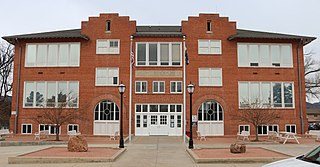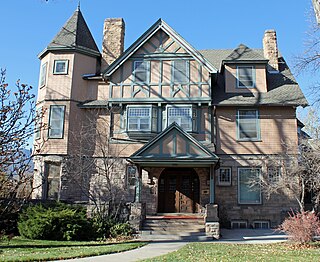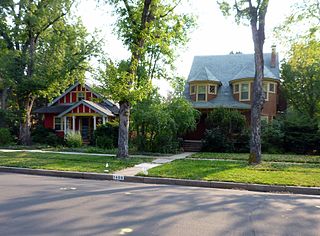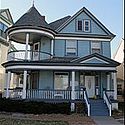
Manitou Springs is a home rule municipality located at the foot of Pikes Peak in western El Paso County, Colorado, United States. The town was founded for its natural mineral springs. The downtown area continues to be of interest to travelers, particularly in the summer, with many shops and restaurants, as well as a creekside city park. The main road through the center of town was one of the direct paths to the base of Pikes Peak. Barr Trail, which winds its way up Pikes Peak, is accessible from town. The subdivision Crystal Hills was added to the municipality in the 1960s.

Cascade is an unincorporated community and U.S. Post Office in El Paso County, Colorado, United States. The ZIP Code of the Cascade Post Office is 80809.

Old Colorado City, formerly Colorado City, was once a town, but it is now a neighborhood within the city of Colorado Springs, Colorado. Its commercial district was listed on the National Register of Historic Places in 1982. It was founded during the Pikes Peak Gold Rush of 1859 and was involved in the mining industry, both as a supply hub and as a gold ore processing center beginning in the 1890s. Residents of Colorado City worked at some of the 50 coal mines of the Colorado Springs area. It was briefly the capital of the Colorado Territory. For many years, Colorado Springs prohibited the use of alcohol within its border due to the lifestyle of Colorado City's opium dens, bordellos, and saloons. It is now a tourist area, with boutiques, art galleries, and restaurants.

Before it was founded, the site of modern-day Colorado Springs, Colorado, was part of the American frontier. Old Colorado City, built in 1859 during the Pike's Peak Gold Rush was the Colorado Territory capital. The town of Colorado Springs, was founded by General William Jackson Palmer as a resort town. Old Colorado City was annexed into Colorado Springs. Railroads brought tourists and visitors to the area from other parts of the United States and abroad. The city was noted for junctions for seven railways: Denver and Rio Grande (1870), Denver and New Orleans Manitou Branch (1882), Colorado Midland (1886-1918), Colorado Springs and Interurban, Atchison, Topeka, and Santa Fe (1889), Rock Island (1889), and Colorado Springs and Cripple Creek Railways. It was also known for mining exchanges and brokers for the Cripple Creek Gold Rush.

Jules Jacques Benois Benedict was one of the most prominent architects in Colorado history, whose works include a number of well-known landmarks and buildings listed on the National Register of Historic Places.

The Inez Johnson Lewis School, also known as Lewis-Palmer School District #38 Administration Building, is a building in Monument, Colorado. It was designed by architects MacLaren & Hetherington of Colorado Springs and was built in 1920. It was listed on the National Register of Historic Places in 1988.

Miramont Castle is a museum located in Manitou Springs, Colorado. The Castle was originally built in 1895 as a private home for Father Jean Baptist Francolon, a French-born Catholic priest. Located in the Manitou Springs Historic District, it is a National Register of Historic Places listing.

Manitou Springs Historic District in Manitou Springs, Colorado is roughly bounded by US 24, Ruxton Avenue, El Paso Boulevard and Iron Mountain Avenue. Listed in the National Register of Historic Places, it is one of the country's largest National Historic Districts.

Cliff House in Manitou Springs, Colorado is a Queen Anne style hotel in the Manitou Springs Historic District. It is a National Register of Historic Places listing. The Cliff House at Pikes Peak is a member of Historic Hotels of America, the official program of the National Trust for Historic Preservation.

Manitou Mineral Springs are natural mineral springs in Manitou Springs, Colorado and Cheyenne Spring House is on the National Register of Historic Places. The springs are located in one of the country's largest National Historic Districts.

Manitou Springs Bridges are historic bridges are located on Park and Canon Avenues over Fountain Creek in Manitou Springs, Colorado. The bridges are on the National Register of Historic Places.

Wheeler Bank is a historic building located on Manitou Avenue in Manitou Springs, Colorado built by Jerome B. Wheeler. It is on the National Register of Historic Places. Over the course of its history, the building has been a financial institution, auditorium and retail business.

Crystal Valley Cemetery is a cemetery located on Plainview Place in Manitou Springs, Colorado. Since its establishment in 1882, it has been the principal cemetery in Manitou Springs. It is listed in the National Register of Historic Places.

Judson Moss Bemis House, also known as Hearthstone Inn, is a historic Queen Anne house in Colorado Springs, Colorado. It is listed in the National Register of Historic Places.

Monument Valley Park is a historic, recreational park in Colorado Springs, Colorado through which Monument Creek flows. It is a National Register of Historic Places listing and is on the Colorado State Register of Historic Properties.

The Eastholme, also known as Eastholme of the Rockies, is a historic building in Cascade, near Colorado Springs, Colorado. It is on the National Register of Historic Places.
Englemann Canyon is a valley along Ruxton Creek, in Manitou Springs, El Paso County, Colorado. It is one of three canyons in Manitou Springs, the others are Ute Pass and Williams Canyon.

The Hagerman Mansion is a historic house located at 610 North Cascade Avenue in Colorado Springs, Colorado.

Gwynne–Love House, also known as Goldmuntz Cascade House, is a historic house in Colorado Springs, Colorado that was placed on the National Register of Historic Places and the Colorado State Register of Historic Properties in 1987.

Old North End Historic District of Colorado Springs, Colorado is located north of Colorado College between Monument Valley Park, an alley between Weber and Nevada Streets, and Uintah and Lilac Streets. It was called North End Historic District until September 2015 when the district boundaries were expanded and the neighborhood was renamed.

























